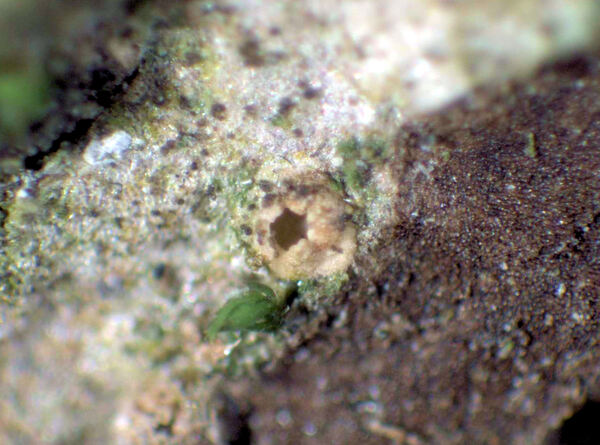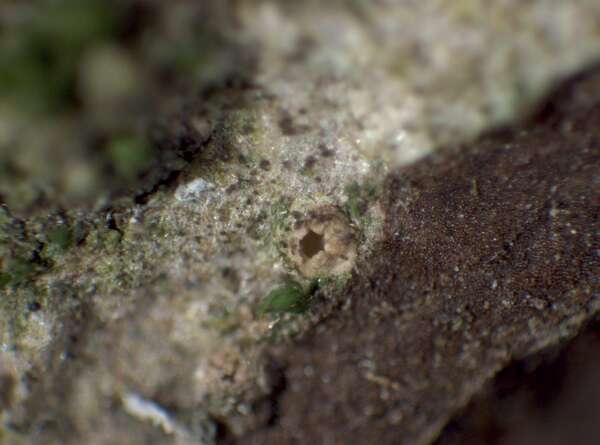Karstenia chrysophaea (Pers.) Coppins, Aptroot & P.F. Cannon
in Cannon & al., Revisions of British and Irish Lichens, 38: 51, 2024. Basionym: Peziza chrysophaea Pers. - Icon. Descr. Fung. 2: 17, tab. 8, fig. 1-2, 1798.
Synonyms: Lecidea chrysophaea (Pers.) Nyl.; Ramonia chrysophaea (Pers.) Vězda; Stictis chrysophaea (Pers.) Pers.
Distribution: N - Frl (Gambera & Tretiach 2003, Tretiach 2004). C - Sar (Rizzi & al. 2011, Di Nuzzo & al. 2022)
Description: Thallus crustose, very thin, continuous, poorly evident, finally often disappearing. Apothecia 0.4-0.7 mm across, 0.15–0.25 mm high, urceolate, at first immersed and perithecioid, with the exciple hiding the disc except for a minute, to 0.5 mm wide pore, later erumpent and with an exposed, pinkish to pale grey-brown disc surrounded by a thick, inrolled proper margin. Proper exciple well developed laterally, the outer part of small, thin-walled, angular cells, the inner part with rectangular cells ending in periphysoids; hymenium colourless, 90-120 µm high, I+ blue at least in upper part; paraphyses slender, simple, slightly swollen at apex; hypothecium colourless. Asci 8-spored, cylindrical-clavate, with a single, thin, K/I- wall layer, and an amyloid exoascus with a ring structure. Ascospores 8-14-septate, hyaline, needle-like to cylindrical, 45-75 x 3-4(-5) µm. Photobiont trentepohlioid. Spot tests: thallus K-, C-, KC-, P-, UV-. Chemistry: without lichen substances.Note: a Mediterranean-Atlantic species found on the soft bark of old trees, especially Ulmus, in humid and shaded situations; inconspicuous and easily overlooked, but certainly not common. It is included in the Italian red list of epiphytic lichens as “Vulnerable” (Nascimbene & al. 2013c).
Growth form: Crustose
Substrata: bark
Photobiont: Trentepohlia
Reproductive strategy: mainly sexual
Most common in areas with a humid-warm climate (e.g. most of Tyrrenian Italy)
Commonnes-rarity: (info)
Alpine belt: absent
Subalpine belt: absent
Oromediterranean belt: absent
Montane belt: absent
Submediterranean belt: extremely rare
Padanian area: absent
Humid submediterranean belt: extremely rare
Humid mediterranean belt: extremely rare
Dry mediterranean belt: absent

Predictive model
Herbarium samples
Growth form: Crustose
Substrata: bark
Photobiont: Trentepohlia
Reproductive strategy: mainly sexual
Most common in areas with a humid-warm climate (e.g. most of Tyrrenian Italy)
Commonnes-rarity: (info)
Alpine belt: absent
Subalpine belt: absent
Oromediterranean belt: absent
Montane belt: absent
Submediterranean belt: extremely rare
Padanian area: absent
Humid submediterranean belt: extremely rare
Humid mediterranean belt: extremely rare
Dry mediterranean belt: absent

Predictive model
| Herbarium samples |




